KFC SuperCoach Draft 2021: A commissioner’s step-by-step guide to setting up your own draft league
Don’t miss your chance to set up your own KFC SuperCoach league with customised rules and a fun draft with your mates. Here’s how to do it.
SuperCoach
Don't miss out on the headlines from SuperCoach. Followed categories will be added to My News.
With great power comes great responsibility, so to those taking charge of a KFC SuperCoach Draft league in 2021, we salute you.
If you’re determined to run a league that’s not just good, but great, setting up your league effectively is key to success. This article will run you through exactly how to do just that.
To kick things off, here’s one golden rule to running a KFC SuperCoach Draft league: Communication is key.
If you and your coaches communicate regularly, the rules will be clear, the banter will flow and the rivalries will be intense.
We recommend creating a private WhatsApp, Messenger or Facebook group with the coaches in your league, so there’s a designated place for memes, banter and trade proposals.
As for the nitty gritty, here’s our step-by-step guide to setting up and managing a successful Draft league.
MORE: BEGINNER’S GUIDE TO SUPERCOACH DRAFT
BEFORE YOU START: Figure out how many coaches are keen to join your league.
If you have a bunch of friends who are keen and committed, just make sure you’ve got an even number and you’re good to go. Your league can have anywhere between four and 20 teams, provided you’ve got an even number.
If you’re one coach short and need a wildcard entrant, feel free to post on the official SuperCoach Facebook group or on Twitter using the #SuperCoach hashtag. You’ll find an extra player in no time.
If you’re keen to have a crack at KFC SuperCoach Draft but don’t know anyone else who is (maybe your mates are rusted-on KFC SuperCoach Classic fanatics), join a public league, or start your own.
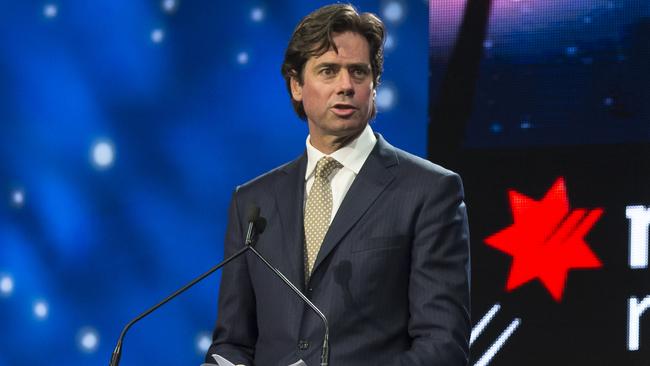
STEP 1: HOW MANY PLAYERS ON EACH TEAM?
The beauty of Draft is you can adjust settings to suit your league.
You can make a league simple and easy by opting for 12-player teams, or more challenging by selecting 22-player teams. If you want to split the difference, there are also a number of 15-player options available.
When you’re sorting through the options, just remember the format goes: Defenders, Midfielders, Rucks, Forwards, Interchange.
For example, 2,2,1,2/5 (12 players) refers to two defenders, two midfielders, one ruckman, two forwards, and five players on the bench for a total of 12 players.
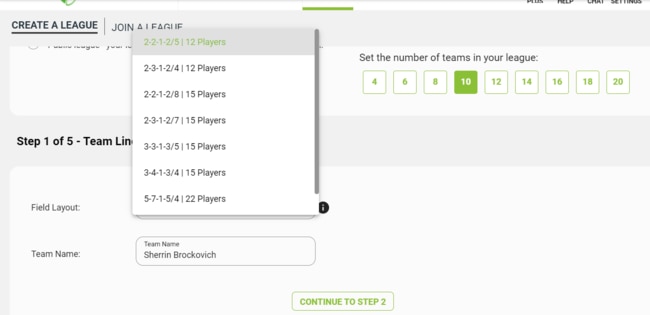
There are two main factors to consider when selecting the amount of players per team — the length of your draft and the difficulty of your competition. Luckily, both can be decided by a magic number.
If you multiply the amount of players on the field by the amount of teams in your league, your magic number will likely be somewhere in the hundreds.
That number will tell you how many minutes your draft will take, assuming you have one minute per pick (more on this later).
The number will also tell you the total number of AFL players who’ll be playing in your competition at any one time.
As a general guide...
If that number is under 200, you’ll likely all be able to field a pretty solid team where the weakest players on your bench are averaging somewhere in the mid-70s. Players like Sam Powell-Pepper, James Aish and Jacob Weitering may be on the cusp of selection, depending on injuries and form.
Once that number climbs above 300, you may be fielding players like Anthony McDonald-Tipungwuti, Jasper Pittard and Brodie Mihocek — players who average under 70 and are unlikely to ever become SuperCoach stars due to their roles.
After 400, things will get harder still. You might find yourself choosing between role players averaging under 60 — the likes of Aliir Aliir and Jordan Roughead. In a competition like this, your weakest players may have as much impact on the weekly results as your star players. This mightn’t be to everyone’s taste.
There’s nothing wrong with a challenging competition, but it’s important coaches know what you’re in for. Whether you’re running a league for casual fans or diehard fantasy players, if you can ensure the format of your league matches coaches’ expectations, they’ll thank you for it.
MORE: THE PHANTOM’S TOP 50 DRAFT RANKINGS
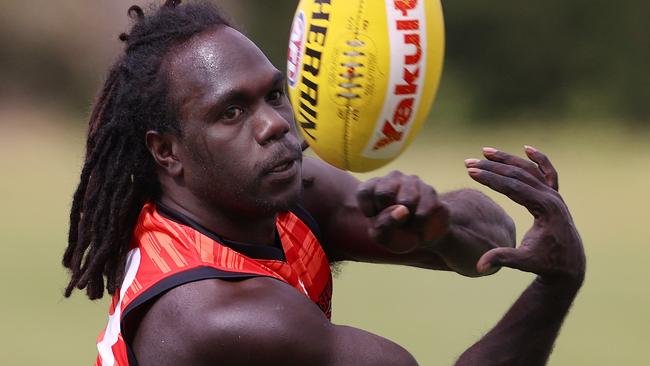
STEP 2: ADJUST THE SEASON SETTINGS TO SUIT YOUR LEAGUE
There are no hard and fast rules here — just a few knobs to twist to ensure your league is just how you like it.
You can play head-to-head matches during the bye rounds or opt out of those weeks, depending on the amount of teams in your league, and your personal preference. Playing matches during the bye rounds adds another layer of strategy; a team desperate for a win might jettison a good player or two to ensure they get a win on the board. This might in turn mean that some good players wind up on the waiver wire at the end of each bye round.
It’s best to think of the five questions in this section as a whole (minus the question on head-to-head games — we strongly recommend you have head-to-head matches turned on), and come up with a fixture that suits the number of teams in your competition.
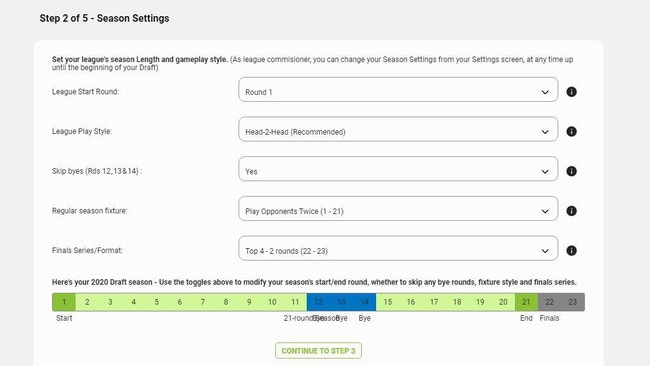
For instance, in an eight-team league…
Starting matches in Round 1 means each team plays each of the seven other teams three times (Rounds 1-21), before a two-week finals series plays out in Rounds 22 and 23 between the top four teams (effectively a mini-finals series where the top four go straight through to preliminary final weekend).
Nice and tidy, with games each week and an even fixture.
Or, in a 20-team league…
Starting matches in Round 2 allows for each team to play every other team once (including matches during the bye rounds) between Rounds 2 and 20, before a three-week finals series featuring the top eight takes place between Rounds 21 and 23.
For some, having an even fixture will be the top priority. For others, having games every week so that no players lose interest might be more important. It’s all up to you — just make sure you pick a format that works for you, and when in doubt, ask the other coaches for their input.
STEP 3: ORGANISE YOUR DRAFT
Similarly to the previous section, it’s best to view this group of settings as a unit.
The main things you’ll need to determine are whether you’re placing a strict time limit on selections, and whether you’ll be able to get everyone together at the same time.
If you haven’t decided on a start time and date with your fellow coaches yet, don’t stress. You can reschedule the start time at any point prior to the start of your draft, so feel free to set a date in the distant future and come back to it once you’ve cemented plans.
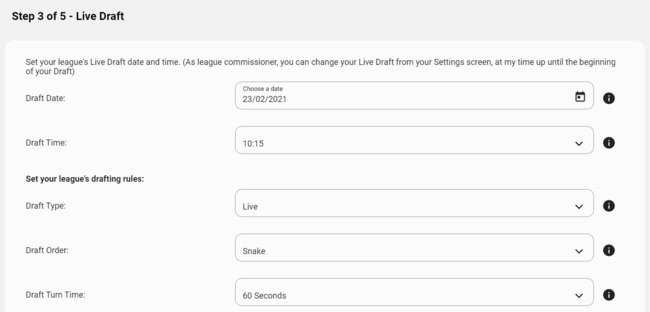
Time limits can be as short as 30 seconds per pick, as long as a day, or anywhere in between. Alternatively, time limits can be removed completely.
In an ideal world, you’d set aside a Sunday, turn on the barbecue and have your mates around to smash out your draft in a few hours.
If you’re setting a time limit, multiplying the magic number listed in Step 2 with the time per pick will let you know exactly how long your draft will take.
In this scenario, either a “Live” or “Live with one computer” (which is exactly as it sounds — all picks are submitted by one computer) Draft type would work best. Coaches who don’t pick a player within the allocated time will have a player selected automatically, so there’s no way your draft can take longer than expected.
Alternatively, if you’re in a big league with lots of coaches with conflicting schedules, or if some of your coaches are in different time zones, an arrangement like the above may not be possible.
In this case, a Live format with no time limit will allow coaches a chance to make selections on their own devices whenever possible. This option also gives coaches plenty of time to weigh up their next selection, which may suit the diehards who have plenty of data to sort through.
A warning, though — if you go down this path, make sure you plan ahead and give yourself plenty of time. Draft selections might trickle in over the course of a week or so, meaning the process could drag out longer than some expect.
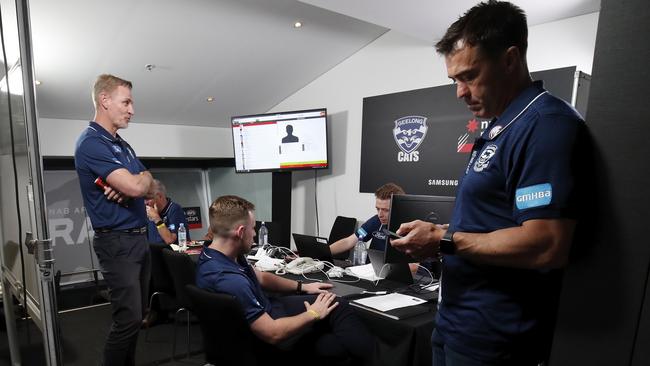
For the extremely time poor, there is an Auto option available — but we don’t recommend it. It’ll select players based on coaches’ pre-draft rankings … but where’s the fun in running a KFC SuperCoach Draft league without a draft!
The final AFL pre-season game is on March 8, so if you want to take a look at players’ pre-season form before your draft night, any date after this but before March 18 (when Round 1 kicks off) is ideal.
As for the Draft order setting, we recommend the Snake option for most leagues.
In a snake league, after all coaches pick their first player the order “snakes” backwards, so the last coach to pick a player in the first round has the first choice in the second round, as it progresses in reverse order.
This means that in a 10-coach league, the picks will be distributed like this:
Coach 1: Pick 1, Pick 20, Pick 21, Pick 40, etc.
Coach 2: Pick 2, Pick 19, Pick 22, Pick 39, etc.
Coach 3: Pick 3, Pick 18, Pick 23, Pick 38, etc.
Coach 4: Pick 4, Pick 17, Pick 24, Pick 37, etc.
Coach 5: Pick 5, Pick 16, Pick 25, Pick 36, etc.
Coach 6: Pick 6, Pick 15, Pick 26, Pick 35, etc.
Coach 7: Pick 7, Pick 14, Pick 27, Pick 34, etc.
Coach 8: Pick 8, Pick 13, Pick 28, Pick 33, etc.
Coach 9: Pick 9, Pick 12, Pick 29, Pick 32, etc.
Coach 10: Pick 10, Pick 11, Pick 30, Pick 31, etc.
Alternatively, the Linear option works the same way as the AFL’s draft. The coach with pick 1 will also have the first pick in every round thereafter, while the coach with the last pick in each round will always be picking last. This option works best in leagues where there’s a big gap between the strongest and weakest coaches, and where there’s a need to even things up. For instance, if you wanted to start a Draft league with your family, the youngest child could have pick 1, the second-youngest pick 2, etc. all the way up to the final pick going to the adult with the most footy knowledge.
The final option is Banzai, where the order of selections snakes backwards in Round 2, stays the same in Round 3, then continues to snake back and forth thereafter. It’s easily the most confusing of the three and not recommended, but might suit leagues where coaches are concerned those with early picks have too great an advantage.
STEP 4: CUSTOMISE YOUR LEAGUE SETTINGS
It’s smooth sailing from here and if you stick with the recommended settings, you can’t really go wrong.
It’s best to have captains turned off, to ensure those with early picks don’t get an unfair advantage. Having Max Gawn’s score doubled every week might sound great to the coach with Pick 1, but the last coach to select a player will undoubtedly feel differently.
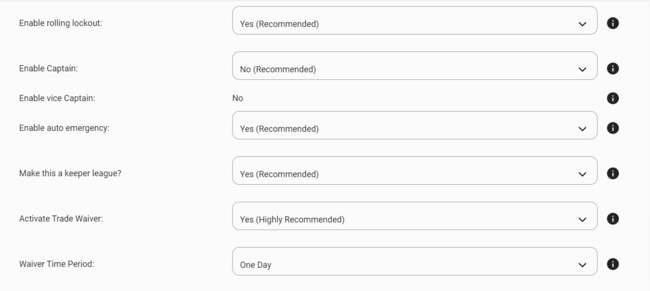
We also recommend making your League a Keeper League, where you can carry over your best players to season 2022 and beyond. This makes for great fun and heightens the strategy involved. Teams in the premiership window can top up their side with seasoned veterans towards the end of a season, while teams out of premiership contention can stock their team with young guns likely to break out the next season. This ensures no coaches lose interest as the season progresses.
We recommend turning League Approval on for trade requests, to ensure uneven trades can be vetoed by other coaches. But hey, if you’re a power-hungry dictator who wants to choose the “Commissioner Approved” option, we won’t stand in your way.
As mentioned earlier, the key to running a successful league is communication, so make sure you spell out your league’s rules before your draft kicks off.
You might think a few setting changes don’t make much difference, but other coaches might build their strategies around certain rules. For instance...
Are you allowing captains?
If yes: Coaches will be more inclined to draft the highest-scoring player regardless of position with their first pick.
If no: Coaches may be less inclined to pick a consistent elite midfielder and might opt for a star forward or defender to ensure their team is balanced.
Is it a keeper league?
If yes: Coaches may opt to select emerging guns, such as Matt Rowell and Sam Walsh, knowing they could get 10 years of service from them.
If no: Coaches might opt for veterans like Travis Boak and Scott Pendlebury, who have been consistent high-end performers for a long time, but are likely to retire in the next few years.
> Sign up for free now and start setting up your KFC SuperCoach Draft league now!
STEP 5: SEND OUT THE INVITES AND LET THE FUN BEGIN
As commissioner, it’s your job to set the tone for your League.
Think of yourself as the captain of a footy club.
If the coaches don’t know each other yet, make sure you introduce them and ensure they’re getting around each other.
Lay down some ground rules in the group chat if necessary, and then start the banter.
There’ll be plenty of opportunities to make your presence felt throughout the year, but your first order of business is figuring out a way to pick your draft order.
If your league’s full of footy nuts who watch pre-season games and wonder why SuperCoach hasn’t started yet, you could each pick a player you think will score well in the Marsh Series. The coach who picks the best-scoring player gets pick 1, the coach with the second-best player gets pick 2, etc.
Alternatively, you could do a sweep with a horse race, assigning one horse to each coach, and letting the order of the horses past the post dictate the order of your draft.
If you’re all getting together for the draft, you could have a table tennis tournament, an eating competition or a Mario Kart showdown to decide the order.
It doesn’t matter how you do it, but get creative and make it fun.
That’s what it’s all about, right?
More Coverage
Originally published as KFC SuperCoach Draft 2021: A commissioner’s step-by-step guide to setting up your own draft league




